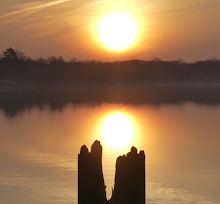After a long night's sleep we woke up to a dry morning with new snow on the mountain tops.
From our Lake Roxburgh Lodge we biked up a steep hill to enter the Clutha Gorge Trail.
First stage would be just 13 kms but the trail surprised us because it was exceeding steep in places and with many and daring switch-backs.
We adjusted speed and vigilance accordingly ...
... and stayed on track.
Lake Roxburgh is a dammed part of Clutha River. The lake is a reservoir for the hydropower plant at the Roxburgh dam.
The Gorge Trail runs along the west side of the lake. The scenery is literally gorgeous and as a biker you have to be "on your toes", because a moment of inattention could easily lead to a long drop over the edge.
The trail ended at Shingle Creek where we had a rendez-vous with a jetboat at 11:30.
The local "taxi driver" Dave gave us and the bikes a 23 kms ride upstream ...
... while he was telling stories, pointing out interesting stuff in the landscape and putting the area and its activities into a historical perspective ...
... like this abandoned homestead dating back from the 1870s and left empty but otherwise intact ...
... and the tiny stone caves used by Chinamen during the gold rush era.
At Doctor's Point Dave put us ashore again and waved goodbye.
We resumed our travel along the Gorge Trail ...
... which now had even more daring stretches. Not recommended for children or the weak-minded vertigo-prone bicyclist.
Eventually we reached the town of Alexandra and the end of the Gorge Trail. The last 10 kms of our biking holiday were spent on the River Trail leading to Clyde along the Clutha.
We crossed the river at Clyde, biked to our accommodation at Dunstan House in downtown, turned in the bikes and the panniers – and got a couple of well-deserved coffees with some homemade software in a nearby café.
After a warm bath it was time to document the effect of Coriolis' Effect on the water draining out of the bathtub. The rotation or spinning of the Earth gives rise to an effect (first described in 1835 by French scientist Gaspard-Gustave de Coriolis) that accelerates draining water in a clockwise direction in the Northern hemisphere and appears to accelerate draining water counterclockwise in the Southern hemisphere. – But if you could look at the draining water in our Clyde bathtub from below, (actually simulating being in the southern hemisphere as opposed to the northern) you would see the draining water spinning in a clockwise direction.
Et voila! There is no real Coreolis difference between the hemispheres, it just appears to be so.
. . . . . .
Tomorrow we will get on an intercity bus and after 5 hours we will be relocated to the coastal town of Oamaru. – Stay tuned !





















































































